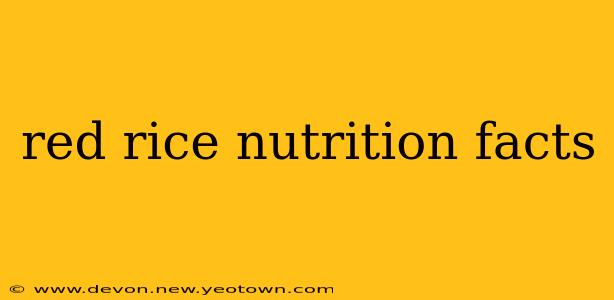Red rice, a delightful and nutritious grain with a rich history, offers a delicious alternative to its more common white counterpart. Beyond its appealing reddish hue, lies a powerhouse of nutrients beneficial for overall health. Let's delve into the nutritional profile of red rice and explore its potential health benefits.
What are the nutritional benefits of red rice?
Red rice boasts a higher concentration of nutrients compared to white rice, largely due to the preservation of the bran and germ during processing. This means it's packed with fiber, antioxidants, and essential minerals. Imagine it as the superhero version of your typical rice, ready to fight off those free radicals and keep your body running smoothly. One cup of cooked red rice provides a significant amount of:
- Fiber: Crucial for digestive health, regulating blood sugar levels, and promoting satiety. That full feeling after a meal? Fiber is your secret weapon.
- Magnesium: Important for muscle function, blood sugar control, and blood pressure regulation.
- Manganese: A vital mineral contributing to bone health, wound healing, and metabolism.
- Antioxidants: These powerful compounds combat cellular damage caused by free radicals, helping protect against chronic diseases. The vibrant red color is a visual cue to the abundance of these beneficial antioxidants.
- Vitamins: Various B vitamins are present, essential for energy production and nerve function.
This nutritional powerhouse makes red rice a valuable addition to a balanced diet.
Is red rice healthier than white rice?
Yes, generally speaking, red rice is considered healthier than white rice. The refining process that transforms brown rice into white rice strips away the bran and germ, removing much of its nutritional value. Red rice, often retaining more of the bran, holds onto a significant portion of these vital nutrients. While white rice offers carbohydrates for energy, red rice provides a much more comprehensive nutritional package. Think of it like this: white rice offers a quick energy boost, while red rice offers sustained energy and a wealth of health benefits.
How many calories are in red rice?
A cup of cooked red rice typically contains around 216 calories. However, this can vary slightly depending on the specific type of red rice and cooking methods. Remember that calories aren't the enemy; a balanced approach to calorie intake, combined with a nutrient-rich diet, is key to maintaining a healthy lifestyle. The nutritional density of red rice makes its calorie count a worthwhile investment in your health.
What are the different types of red rice?
Several varieties of red rice exist, each with its unique characteristics and flavor profiles. While the nutritional content remains largely similar across varieties, the texture and taste can differ. Some popular types include:
- Thai Red Rice: Known for its nutty flavor and slightly chewy texture.
- Black Rice (sometimes considered a red rice variety): This dark-colored rice is prized for its intense anthocyanin content, which gives it its distinctive color and contributes significantly to its antioxidant properties.
How can I incorporate red rice into my diet?
Red rice is incredibly versatile and can be easily incorporated into your daily meals. It can be used as a base for bowls, added to stir-fries, or served as a side dish. Get creative! Its slightly nutty flavor pairs well with both sweet and savory dishes.
What are the potential health benefits of red rice?
The abundance of nutrients in red rice translates to a range of potential health benefits, including:
- Improved Digestion: High fiber content promotes regularity and healthy bowel movements.
- Better Blood Sugar Control: Fiber helps regulate blood sugar levels, making it a suitable choice for individuals managing diabetes.
- Reduced Risk of Chronic Diseases: The antioxidants fight free radicals, potentially reducing the risk of heart disease and certain cancers.
- Increased Energy Levels: The sustained release of carbohydrates provides consistent energy throughout the day.
Red rice, with its appealing color and impressive nutritional profile, isn't just a grain; it's a healthy and delicious addition to a balanced diet. Its versatility and rich flavor profile make it a welcome addition to a wide array of culinary creations. So, next time you're planning your meals, consider adding this ancient grain to your shopping list and experience the delightful taste and remarkable health benefits it offers.

